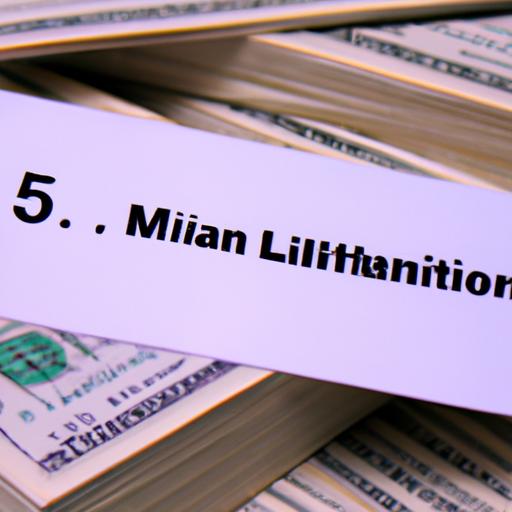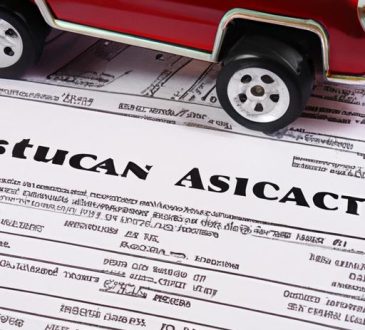
Whether you’re a small business owner or a freelancer, protecting yourself and your assets from potential lawsuits and claims is crucial. Liability insurance acts as a safety net, providing coverage for legal costs and damages in case of an unfortunate incident. However, the cost of liability insurance can vary significantly depending on several factors. In this article, we will delve into the importance of liability insurance and help you understand the factors that influence the cost, specifically focusing on the $5 million liability insurance coverage.
1. Importance of Liability Insurance
Imagine facing a situation where a customer slips and falls in your store, resulting in injuries. Without liability insurance, you could be held personally responsible for medical expenses, legal fees, and potential compensation. Liability insurance offers protection against these unforeseen events, giving you peace of mind and safeguarding your financial stability. It acts as a shield that shields your business and personal assets from potential claims, ensuring that you can continue operating without worrying about crippling legal liabilities.
2. Understanding the Cost Factor
Now that we understand the importance of liability insurance, let’s explore the factors that contribute to the cost. Insurance companies consider various aspects when determining the premium for your $5 million liability coverage. These factors include:
-
Coverage Limits: Higher coverage limits typically result in higher premiums. The $5 million liability insurance coverage provides substantial protection but can come with a higher price tag compared to lower coverage limits.
-
Type of Business: The nature of your business plays a significant role in determining the cost. Certain industries, such as construction or healthcare, inherently carry more risk, which can lead to higher premiums.
-
Industry Risk Factors: Insurance companies evaluate the risks associated with your specific industry. They consider factors like previous claims history, industry regulations, and overall risk exposure.
-
Claims History: Your past claims can impact your insurance cost. If you have a history of claims, insurers may view your business as higher risk and charge higher premiums accordingly.
-
Location: The location of your business can also affect the cost. Areas with higher crime rates or extreme weather conditions may result in increased premiums.
Understanding these factors can help you navigate the realm of liability insurance and make informed decisions when it comes to protecting your business. In the next section, we will explore the average cost of $5 million liability insurance coverage and delve into specific scenarios to provide you with a clearer picture. Stay tuned!
Factors Affecting Liability Insurance Cost
When it comes to determining the cost of liability insurance, several factors come into play. Insurance providers assess these factors to calculate the premium for your $5 million liability insurance coverage. Let’s take a closer look at the key factors that influence the cost:
A. Coverage Limits
Coverage limits refer to the maximum amount an insurance policy will pay out in the event of a claim. Higher coverage limits provide greater protection but also come with a higher price tag. The $5 million liability insurance coverage offers substantial protection, which may result in a higher premium compared to lower coverage limits. Assessing your business’s needs and evaluating potential risks can help determine the appropriate coverage limits for your specific situation.
B. Type of Business
The type of business you operate directly impacts the cost of liability insurance. Insurance providers categorize businesses into different risk profiles based on their industry, operations, and services offered. Industries with higher risks, such as construction or healthcare, typically have higher insurance premiums compared to lower-risk sectors. Insurance companies consider the likelihood of claims and the potential severity of damages when determining the cost.
C. Industry Risk Factors
Within each industry, specific risk factors can affect the cost of liability insurance. Insurance providers evaluate the unique risks associated with different industries. For example, a restaurant may face risks related to food safety and slip-and-fall incidents, while a technology company may face risks related to data breaches and intellectual property disputes. Understanding the risk factors relevant to your industry can help you anticipate potential liabilities and obtain appropriate coverage.
D. Claims History
Your claims history also plays a crucial role in determining the cost of liability insurance. Insurance providers consider your past claims, including the frequency and severity of incidents. If you have a history of claims, insurers may view your business as higher risk, leading to higher premiums. Demonstrating a proactive approach to risk management and implementing safety measures can help mitigate the impact of claims history on insurance cost.
E. Location
The geographical location of your business can impact the cost of liability insurance. Insurance providers consider factors such as crime rates, weather conditions, and legal environment when assessing the risk associated with a particular location. Areas with higher crime rates or extreme weather events may have higher insurance premiums due to increased risks.
By understanding and evaluating these factors, you can gain insights into how insurance providers calculate the cost of liability coverage. In the next section, we will explore the average cost of $5 million liability insurance and provide real-life scenarios to give you a better understanding of the potential expenses involved. Let’s dive in!
Exploring the Average Cost of $5 Million Liability Insurance
When it comes to liability insurance, having a clear understanding of the average cost for $5 million coverage is essential. Let’s dive into the details and explore different aspects that can influence the price.
A. Overview of Liability Insurance Coverage Options
Before we delve into the cost, it’s crucial to understand the various coverage options available for liability insurance. Generally, liability insurance offers protection against bodily injury, property damage, and personal injury claims. Depending on your business needs, you can opt for different types of liability coverage, including:
-
General Liability Insurance: This coverage protects against claims related to third-party bodily injury or property damage occurring on your premises or as a result of your business operations.
-
Professional Liability Insurance: Also known as errors and omissions (E&O) insurance, this coverage is specific to professionals and provides protection against claims arising from professional negligence or mistakes.
-
Product Liability Insurance: If your business involves manufacturing or selling products, product liability insurance safeguards against claims resulting from faulty products causing injuries or property damage.
Understanding the coverage options available allows you to tailor your insurance policy to meet your specific needs, ensuring comprehensive protection.
B. General Price Range for $5 Million Liability Insurance
The cost of $5 million liability insurance can vary based on several factors we discussed earlier. However, to provide a general idea, the average price range for $5 million liability coverage falls between $1,000 and $3,000 per year. This estimate can vary depending on your industry, location, claims history, and other relevant factors.
It’s important to note that this is an approximate range and actual premiums can differ based on your unique circumstances. To obtain accurate pricing information, it’s recommended to consult multiple insurance providers and request personalized quotes.
C. Case Studies: Different Business Scenarios
To further illustrate the cost implications, let’s examine a few hypothetical business scenarios. Keep in mind that these are just examples and actual costs may vary significantly.
-
Small Retail Store: A small retail store with low-risk operations and no previous claims history may expect to pay around $1,200 per year for $5 million liability insurance.
-
Contractor or Construction Business: Given the higher risk associated with the construction industry, a contractor or construction business may face premiums ranging from $2,000 to $4,000 per year for the same coverage.
-
Professional Service Provider: Professionals such as consultants or accountants often require professional liability insurance. The cost for $5 million coverage in this case can range from $1,500 to $3,500 per year.
By considering these case studies, you can gain a better understanding of how different factors impact the cost of $5 million liability insurance coverage. In the next section, we will explore practical tips to help you reduce the cost and make the most of your insurance investment. Stay tuned!
4. Tips to Reduce $5 Million Liability Insurance Cost
Managing the cost of your $5 million liability insurance coverage doesn’t have to be overwhelming. By implementing these practical tips, you can potentially reduce your insurance expenses while still maintaining adequate coverage.
A. Risk Management Strategies
Implementing effective risk management strategies can help mitigate potential risks, which can lead to lower insurance premiums. Take proactive measures to ensure the safety of your premises, employees, and customers. Conduct regular inspections, address any potential hazards promptly, and provide proper training to your staff. By demonstrating your commitment to risk management, insurance companies may view your business as less risky, resulting in reduced premiums.
B. Bundling Insurance Policies
Consider bundling your liability insurance policy with other insurance coverages, such as property insurance or workers’ compensation. Insurance companies often offer discounts for bundling policies, allowing you to save on overall insurance costs. Additionally, having all your insurance policies with the same provider simplifies the management and streamlines the claims process.
C. Increasing Deductibles
Adjusting your deductibles is another way to potentially lower your insurance premiums. A deductible is the amount you agree to pay out of pocket before the insurance coverage kicks in. By opting for higher deductibles, you take on more financial responsibility in the event of a claim, which can result in lower premiums. However, it’s essential to carefully assess your financial capabilities and consider the potential impact of higher deductibles on your business’s cash flow.
D. Comparing Multiple Insurance Quotes
Don’t settle for the first insurance quote you receive. Take the time to shop around and obtain quotes from multiple insurance providers. Each company may have different pricing structures and coverage options. By comparing quotes, you can identify the most competitive rates that align with your business needs. Remember to consider not only the cost but also the reputation and reliability of the insurance provider.
Implementing these tips can help you navigate the realm of liability insurance cost management. However, it’s crucial to strike the right balance between cost savings and adequate coverage. In the next section, we will emphasize the importance of choosing a reputable insurance provider to ensure you receive the necessary support when it matters the most. Keep reading!
Importance of Choosing a Reputable Insurance Provider
When it comes to selecting a liability insurance provider, it’s essential to choose one that you can trust. The right insurance company will not only offer competitive pricing but also provide the necessary support and coverage when you need it the most. Here are some key factors to consider when evaluating insurance providers:
A. Evaluating Financial Stability
Before committing to an insurance company, it’s crucial to assess their financial stability. A financially stable insurer ensures that they have the resources to fulfill their obligations and pay out claims promptly. You can evaluate financial stability by reviewing the insurer’s credit ratings from reputable rating agencies like Standard & Poor’s or Moody’s. Additionally, consider their track record and longevity in the industry, as this can provide insights into their financial health.
B. Checking Customer Reviews and Ratings
Customer reviews and ratings can provide valuable insights into the quality of service and customer satisfaction offered by an insurance provider. Take the time to read reviews and testimonials from policyholders to gauge their overall experience. Look for patterns of positive or negative feedback regarding claims processing, customer service, and responsiveness. Online platforms and forums dedicated to insurance discussions can be valuable sources of information to help you make an informed decision.
C. Assessing Claims Handling Process
In the unfortunate event that you need to file a claim, a reputable insurance provider will have a streamlined and efficient claims handling process in place. Research how the insurance company handles claims, including the ease of reporting, the responsiveness of their claims team, and the speed at which they process and settle claims. Opt for an insurer known for their fair and efficient claims settlement practices, as this can significantly impact your experience during a difficult time.
Choosing a reputable insurance provider is vital to ensure that you receive the support and coverage you need when the unexpected happens. By evaluating the financial stability, considering customer reviews and ratings, and assessing the claims handling process, you can increase your chances of finding a reliable insurer that meets your specific requirements. In the concluding section, we will summarize the key takeaways and emphasize the importance of securing adequate coverage.
Conclusion
In conclusion, securing $5 million liability insurance coverage is a wise investment for any business owner or freelancer. It provides essential protection against potential lawsuits and claims, safeguarding your assets and ensuring your financial stability. By understanding the factors that influence the cost of liability insurance, you can make informed decisions and find the coverage that suits your needs.
Remember, when considering liability insurance, it’s crucial to evaluate the cost-benefit ratio. While the premiums may seem high, the potential financial devastation that could result from a lawsuit can far outweigh the cost of insurance. By having adequate coverage, you can focus on running your business or offering your services without constantly worrying about the potential legal liabilities.
When choosing an insurance provider, consider their expertise, authority, and trustworthiness. Evaluate their financial stability, read customer reviews, and assess their claims handling process. It’s essential to partner with a reputable company that will be there for you when you need them the most.
At insurance.codepel.com, we understand the significance of liability insurance and are here to help you navigate the complexities. Our team of experts will provide personalized guidance, ensuring you find the right coverage at the best possible price. Remember, it’s not just about the cost of insurance, but the peace of mind it brings.
So, don’t delay. Take the necessary steps to secure your financial future and protect your business. Reach out to insurance.codepel.com today and let us assist you in finding the perfect $5 million liability insurance coverage. Remember, peace of mind is priceless, and we’re here to help you achieve it.



